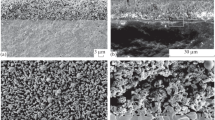Abstract
A comparative analysis of the features of the formation, morphology, and electrochemical activity of composite anodes of solid oxide fuel cells was performed using nanosized particles of NiO and Ce0.8Gd0.2O2 – δ. The direct introduction of NiO nanoparticles into cermet composition leads to technological problems during screen printing of electrode layers associated with the oxidation of organic components of electrode pastes with oxygen, which is desorbed from the NiO surface. Such problems can be solved by pre-heating treatment of NiO. However, this treatment and subsequent firing of the anodes leads to an increase in the particle size to submicron. An increase in electrochemical activity can be achieved by impregnating the anodes with the formation of nanosized catalytically active particles on their surface.









Similar content being viewed by others
REFERENCES
Solid Oxide Fuels Cells: Facts and Figures: Past Present and Future Perspectives for SOFC Technologies, Ed. by J. T. S. Irvine and P. Connor (Springer, London, Heidelberg, New York, Dordrecht, 2013).
G. Kaur, “SOFC technology: Its working and components,” in Solid Oxide Fuel Cell Components (Springer, Cham, Switzerland, 2016), p. 79.https://doi.org/10.1007/978-3-319-25598-9_3
Z. Shao and M. O. Tade, Intermediate-Temperature Solid Oxide Fuel Cells: Materials and Applications (Springer, Berlin, Heidelberg, 2016). https://doi.org/10.1007/978-3-662-52936-2
K. Huang and J. B. Goodenough, Solid Oxide Fuel Cell Technology: Principles, Performance and Operations (CRC, Woodhead, 2009).
Solid Oxide Fuel Cells: From Materials to System Modeling, Ed. by M. Ni and T. S. Zhao (Roy. Soc. Chem., London, 2013).
E. V. Tsipis and V. V. Kharton, J. Solid State Electrochem. 12, 1367 (2008).
E. V. Tsipis and V. V. Kharton, J. Solid State Electrochem. 15, 1007 (2011).
V. N. Chebotin and M. V. Perfil’ev, Electrochemistry of Solid Electrolytes (Khimiya, Moscow, 1978) [in Russian].
E. V. Tsipis and V. V. Kharton, J. Solid State Electrochem. 12, 1039 (2008).
E. D. Wachsman and K. T. Lee, Science (Washington, DC, U. S.) 334, 935 (2011).
V. V. Kharton, E. N. Naumovich, V. N. Tikhonovich, et al., J. Power Sources 79, 242 (1999).
V. V. Kharton, E. V. Tsipis, I. P. Marozau, et al., Solid State Ionics 178, 101 (2007).
I. Burmistrov, D. Agarkov, S. Bredikhin, et al., ECS Trans. 57, 917 (2013).
I. N. Burmistrov, D. A. Agarkov, E. V. Korovkin, et al., Russ. J. Electrochem. 53, 873 (2017).
I. Kuritsyna, V. Sinitsyn, A. Melnikov, et al., Solid State Ionics 262, 349 (2014).
Funding
This work was supported by the Russian Science Foundation (grant no. 20-19-00478).
Author information
Authors and Affiliations
Corresponding author
Rights and permissions
About this article
Cite this article
Tsipis, E.V., Burmistrov, I.N., Agarkov, D.A. et al. Formation and Electrochemical Activity of Nanostructured Anodes of Solid Oxide Fuel Cells in Hydrogen-Containing Atmospheres. Nanotechnol Russia 15, 356–362 (2020). https://doi.org/10.1134/S1995078020030143
Received:
Revised:
Accepted:
Published:
Issue Date:
DOI: https://doi.org/10.1134/S1995078020030143



